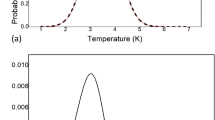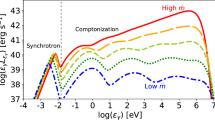Abstract
THE microwave radiation discovered by Penzias and Wilson1 fitted into the theory of the big-bang universe proposed by Gamow2 and Dicke et al.3, which predicts a residual radiation with a temperature of ∼ 3° K from the cooling of the primordial radiation. Measurement of the strength of the microwave radiation at different wavelengths4 and the inferred strength at 2.3 mm fitted the blackbody curve with a temperature of 2.7° K (Fig. 1). Supporters of the steady state universe5,6, however, are contesting this interpretation and suggest that the radiation may be the result of the superposition of “sources” or the scattering of source radiation by “dust grains”. At present, there are no direct experimental measurements of microwave radiation below a wavelength of 7 mm to show that the radiation is either a blackbody radiation of temperature 2.7° K or the type predicted by Narlikar and Wickramasinghe6. In this report I shall derive upper limits on the intensity of the microwave radiation below a wavelength of 1.7 mm using cosmic ray data to indicate the nature of the radiation.
This is a preview of subscription content, access via your institution
Access options
Subscribe to this journal
Receive 51 print issues and online access
$199.00 per year
only $3.90 per issue
Buy this article
- Purchase on Springer Link
- Instant access to full article PDF
Prices may be subject to local taxes which are calculated during checkout
Similar content being viewed by others
References
Penzias, A. A., and Wilson, R. W., Astrophys. J., 142, 419 (1965).
Gamow, G., in Vistas in Astronomy (edit. by Beer, A.), 2, 1726 (Pergamon Press, New York, 1956).
Dicke, R. H., Peebles, P. J. E., Roll, P. G., and Wilkinson, D. T., Astrophys. J., 142, 414 (1965).
Shakeshaft, J. R., and Webster, A. S., Nature, 217, 339 (1968).
Hoyle, F., and Wickramasinghe, N. C., Nature, 214, 969 (1967).
Narlikar, J. V., and Wickramasinghe, N. C., Nature, 216, 43 (1967).
Apparao, M. V. K., Proc. Ind. Acad. Sci., 65 A, 349 (1967).
Fazio, G. G., Ann. Rev. Astron. Astrophys., 5, 481 (1967).
Fazio, G. G., Helmken, H. F., Cavrak, jun., S. J., and Hearn, D. R., Canad. J. Phys. (in the press).
Author information
Authors and Affiliations
Rights and permissions
About this article
Cite this article
APPARAO, M. Upper Limits on Universal Microwave Radiation below λ = 1.7 mm. Nature 219, 709–710 (1968). https://doi.org/10.1038/219709a0
Received:
Issue Date:
DOI: https://doi.org/10.1038/219709a0
This article is cited by
-
The relic radiation spectrum and the thermal history of the universe
La Rivista Del Nuovo Cimento Series 2 (1977)
Comments
By submitting a comment you agree to abide by our Terms and Community Guidelines. If you find something abusive or that does not comply with our terms or guidelines please flag it as inappropriate.



